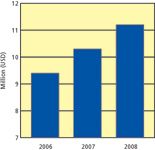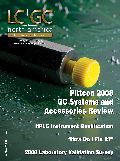Lab Spray Dryers
Lab Spray Dryers
Spray drying is the most widely used industrial process involving particle formation and drying. It is highly suited for the continuous production of dry solids in either powder, granulate or agglomerate form from liquid feedstocks as solutions, emulsions and pumpable suspensions. The technique is applied in almost every industrial sector, but has found the most utility in the food, chemicals and pharmaceuticals industries. In fact, these industries must comply with quality standards regarding particle size distribution, residual moisture content, bulk density, and particle shape.

2006 extraction technique product type.
Traditionally, spray drying was reserved for pilot and process scale applications, but opportunities to replace other drying technologies have revitalized the laboratory-scale market. Other drying technologies require further sample processing like grinding and filtering, which produce irregular particle sizes, but laboratory spray drying can produce more uniform particle sizes and better consistency.
Spray drying involves the evaporation of moisture by atomizing or spraying the feed solution into a heated drying chamber. Fine droplets formed by the spray of the feed solution dramatically increase the surface area for evaporation, allowing for fast, high-volume production of dry powders.
As simple as the principles of spray drying might seem, the instrument engineering and design is important to achieve the desired product properties. The mixing of the droplets and the drying air is perhaps the most important aspect of the process. A co-current flow design, in which the droplets and drying air move through the drying chamber in the same direction, is well suited for heat-sensitive products. In counter-current flow, the droplets and drying air move through the drying chamber in opposite directions. This flow design is suited only for thermally stable products.
The foregoing data was extracted and adapted from SDi's Lab Equipment Market Brief: Evaporators and Concentrators. For more information, contact Glenn Cudiamat, VP of Research Services, Strategic Directions International, Inc., 6242 Westchester Parkway, Suite 100, Los Angeles, CA 90045, (310) 641-4982, fax: (310) 641-8851, e-mail: cudiamat@strategic-directions.com

Regulatory Deadlines and Supply Chain Challenges Take Center Stage in Nitrosamine Discussion
April 10th 2025During an LCGC International peer exchange, Aloka Srinivasan, Mayank Bhanti, and Amber Burch discussed the regulatory deadlines and supply chain challenges that come with nitrosamine analysis.
Top Execs from Agilent, Waters, and Bruker Take the Stage at J.P. Morgan Healthcare Conference
January 16th 2025The 43rd Annual Healthcare J.P. Morgan Healthcare Conference kicked off in San Francisco earlier this week. Here’s what top executives from Agilent, Bruker, and Waters, discussed during the event.






